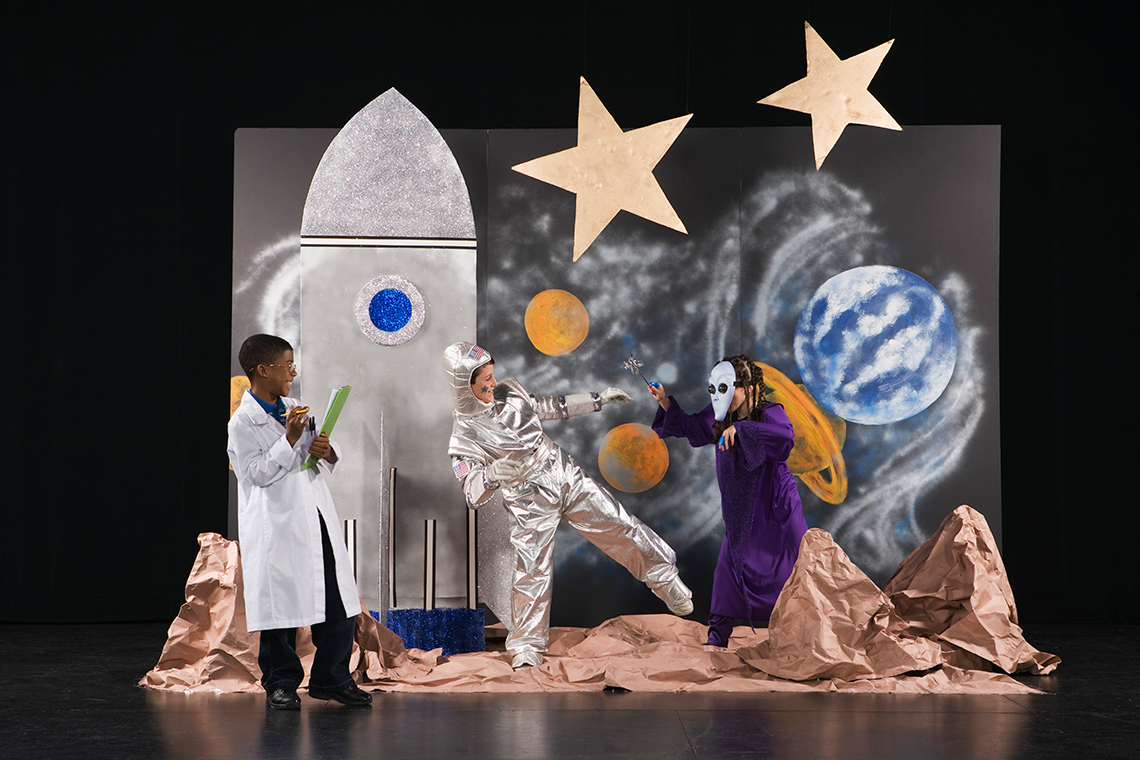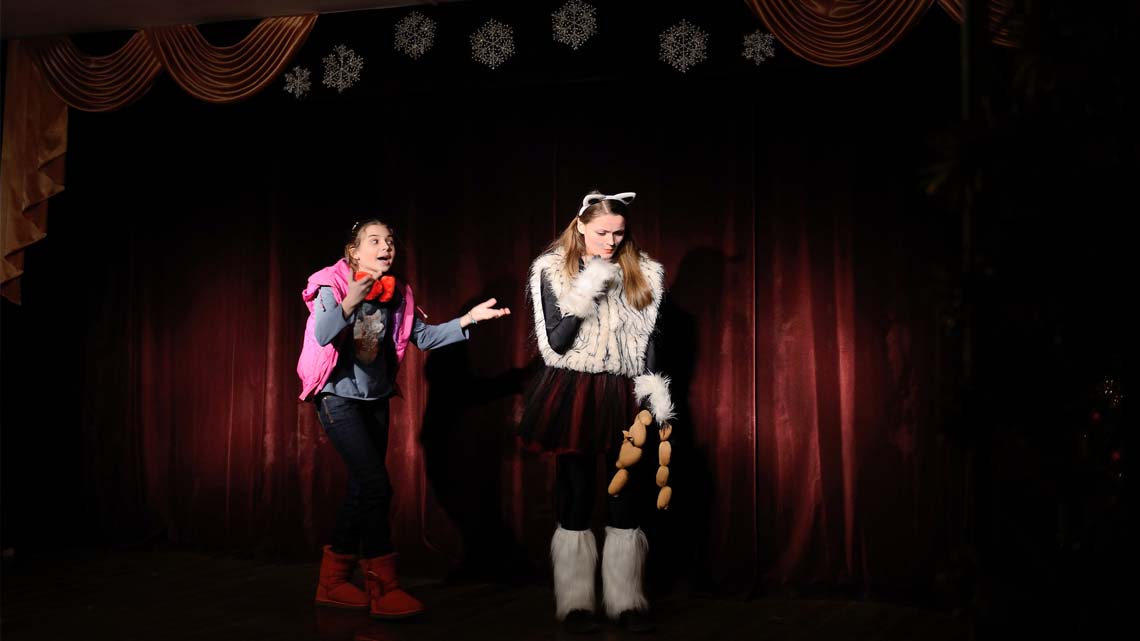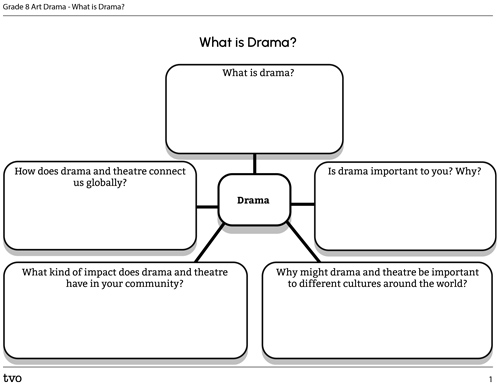Minds On
Warm up
Don’t forget to do your safety check!
Warm Up
Breathing activity
Find a comfortable place to lie on your back with your legs stretched in front of you or sit in a comfortable spot. Place a small pillow or a soft object of your choice onto your stomach.
As you breathe deeply, you should feel the object rise and then fall as you breathe out.
Take a few more deep breaths.

If you wish, you can access this recording entitled “Deep Breathing” to complete your breathing activity.
Deep Breathing
Drama game
If possible, set a timer for 3 minutes. In those 3 minutes, record anything about yourself that is associated or has a connection with any of the words given:
- apple
- grass
- Pacific Ocean
- a week
- running
For example, if the word ‘London’ was in the list, you could write, “I went to London last month.” Or “London is where I’d like to live one day.”
At the end of 3 minutes, stop recording. If possible, share your connection with a partner.
Let’s get started
Brainstorm
Brainstorm
Consider the following questions about drama.
- What is drama?
- Is drama important to you? Why?
- Why might drama and theatre be important to different cultures around the world?
- What kind of impact does drama and theatre have in your community?
- How does drama and theatre connect us globally?
Brainstorm your ideas using the word web provided or in a method of your choice.
Complete the What is Drama? in your notebook or using the following fillable and printable document. If you would like, you can use speech-to-text or audio recording tools to record your thoughts. Consider adding your work to your drama portfolio.
Action
Get ready, get set…
Drama is a way to bring people in a community together. It is a way to educate and a way to entertain people.
Press the following tabs to access other important facts about drama.

We can use plays to think deeply about problems in our society.
We can use improvisation to make people laugh while thinking about how we can all make a difference. Improvisation is when something is created without preparation.

Drama is based in the tradition of storytelling. Communities have been engaging in storytelling for centuries. It is part of oral tradition.
Elders and Knowledge Keepers from Indigenous communities play an important role in preserving and passing on their histories, traditions, teachings, and knowledge from one generation to the next. Each nation has its own story about how the world and its people, clans, governance, traditions, and more were created. These are not “myths” or “legends,” rather they are called creation stories. Some stories are only told to particular people or in particular settings. Furthermore, some stories are protected and are only told within the community.
Aesop’s fables
In the mid-6th century BCE, Aesop, who was a former enslaved person in Greece, wrote tales called fables. These 725 fables were often shared using the storytelling tradition of passing the tales orally from person to person but were also available for children to learn to read. These fables, as written, were not long stories. They would begin with a setting and a situation and then move quickly into the “punchline” or the moral (lesson) of the tale.
Press the following tabs to access more information about Aesop’s fables.
These fables were created as an entertaining way to teach life’s lessons about the proper ways to behave and what could happen if someone made a decision not to behave correctly. These stories were a way for children to learn the challenges faced by adults at an early age.
The main characters of these fables were almost always animals and insects who behaved as humans. They spoke and moved as humans and imitated human behaviours. These characters behaved in a child-like manner and often appeared in more than one fable. Each time they appeared, they behaved a little differently.
At the end of the fable, the lesson to be learned, or the moral, would be expressed in a short sentence.

Explore the four fables below.
- Why were the morals of these fables important in the past? Are they still relevant now? Why or why not?
- What do notice about the style and structure of the fables?
Record your thinking in a method of your choice.
Press the following tabs to access four different fables.
A Lion lay asleep in the forest, his great head resting on his paws. A timid little Mouse came upon him unexpectedly, and in her fright and haste to get away, ran across the Lion’s nose. Roused from his nap, the Lion laid his huge paw angrily on the tiny creature.
“Spare me!” begged the poor Mouse. “Please let me go and some day I will surely repay you.”
The Lion was much amused to think that a Mouse could ever help him. But he was generous and finally let the Mouse go.
Some days later, while stalking his prey in the forest, the Lion was caught in the toils of a leftover fishing net. Unable to free himself, he filled the forest with his angry roaring. The Mouse knew the voice and quickly found the Lion struggling in the net. Running to one of the great ropes that bound him, she gnawed it until it parted, and soon the Lion was free.
“You laughed when I said I would repay you,” said the Mouse. “Now you see that even a Mouse can help a Lion.”
A kindness is never wasted.
A store of honey had been found in a hollow tree, and the Wasps declared positively that it belonged to them. The Bees were just as sure that the treasure was theirs. The argument grew very pointed, and it looked as if the affair could not be settled without a battle, when at last, with much good sense, they agreed to let a judge decide the matter. So they brought the case before the Hornet, justice of the peace in that part of the woods.
When the Judge called the case, witnesses declared that they had seen certain winged creatures in the neighbourhood of the hollow tree, who hummed loudly, and whose bodies were striped, yellow and black, like Bees.
Counsel for the Wasps immediately insisted that this description fitted his clients exactly.
Such evidence did not help Judge Hornet to any decision, so he adjourned court for six weeks to give him time to think it over. When the case came up again, both sides had a large number of witnesses. An Ant was first to take the stand, and was about to be cross-examined, when a wise old Bee addressed the Court.
“Your honor,” he said, “the case has now been pending for six weeks. If it is not decided soon, the honey will not be fit for anything. I move that the Bees and the Wasps be both instructed to build a honey comb. Then we shall soon see to whom the honey really belongs.”
The Wasps protested loudly. Wise Judge Hornet quickly understood why they did so: They knew they could not build a honey comb and fill it with honey.
“It is clear,” said the Judge, “who made the comb and who could not have made it. The honey belongs to the Bees.”
Ability proves itself by deeds.
A Hare was making fun of the Tortoise one day for being so slow.
“Do you ever get anywhere?” he asked .
“Yes,” replied the Tortoise, “and I get there sooner than you think. I’ll run you a race and prove it.”
The Hare was much amused at the idea of running a race with the Tortoise, but for the fun of the thing he agreed. So the Fox, who had consented to act as judge, marked the distance and started the runners off.
The Hare was soon far out of sight, and to make the Tortoise feel very deeply how ridiculous it was for him to try a race with a Hare, he lay down beside the course to take a nap until the Tortoise should catch up.
The Tortoise meanwhile kept going slowly but steadily, and, after a time, passed the place where the Hare was sleeping. But the Hare slept on very peacefully; and when at last he did wake up, the Tortoise was near the goal. The Hare now ran his swiftest, but he could not overtake the Tortoise in time.
The race is not always to the swift.
The Mice once called a meeting to decide on a plan to protect themselves from the Cat. At least they wished to find some way of knowing when she was coming, so they might have time to run away. Indeed, something had to be done, for they lived in such constant fear of her claws that they hardly dared stir from their dens by night or day.
Many plans were discussed, but none of them was thought good enough. At last, a very young Mouse got up and said:
“I have a plan that seems very simple, but I know it will be successful.
All we have to do is to hang a bell about the Cat’s neck. When we hear the bell ringing, we will know immediately that our enemy is coming.”
All the Mice were much surprised that they had not thought of such a plan before. But in the midst of rejoicing over their good fortune, an old Mouse arose and said:
“I will say that the plan of the young Mouse is very good. But let me ask one question: Who will bell the Cat?”
It is one thing to say that something should be done, but quite a different matter to do it.
Pause and Reflect
Pause and reflect
- Which of the fables did you connect with the most? Why?
- Do you think that the morals of fables can be considered global morals? Why or why not?
Respond in a method of your choice.

For each statement, select the whether it is true or false based on your learning about Aesop’s fables.
Go!
Drama production
Access this video to explore a drama production trailer.
What do you notice about these productions that is shared in the production video?
Press ‘Hint’ to access ideas to help you answer the question.
Consider the types of costumes, the use of props, the set design.
How might this theatre company perform Aesop’s fables onstage?
Press ‘Possible Answer’ to access one way to answer this question.
It appears that they use humour (the large gestures).
At the beginning of the trailer, the words “Classic Stories Re-Imagined for Today” appear. What do you think that might mean?
Press ‘Possible Answer’ to access a possible answer.
Possible answer: They take the stories and make them relevant to situations that people find themselves in today.
Tableau
What is tableau?
Tableau is a group of silent, motionless figures used to represent a scene, theme, or abstract idea (e.g., peace, joy), or an important moment in a narrative. Tableaux may be presented as stand-alone images to communicate one specific message or may be used to achieve particular effects in a longer drama work.
Explore this video entitled “What is a Tableau?” to learn about the four different features of a tableau. The four features are stillness, facial expressions, filling the space, and levels.
Plan a series of tableaux which shares the important ideas in the fable. Once you have decided the individual freeze frames, plan the transitions between movements.
Record your ideas using a method of your choice.
Press the following tabs to choose one fable.
A Lion lay asleep in the forest, his great head resting on his paws. A timid little Mouse came upon him unexpectedly, and in her fright and haste to get away, ran across the Lion’s nose. Roused from his nap, the Lion laid his huge paw angrily on the tiny creature.
“Spare me!” begged the poor Mouse. “Please let me go and some day I will surely repay you.”
The Lion was much amused to think that a Mouse could ever help him. But he was generous and finally let the Mouse go.
Some days later, while stalking his prey in the forest, the Lion was caught in the toils of a leftover fishing net. Unable to free himself, he filled the forest with his angry roaring. The Mouse knew the voice and quickly found the Lion struggling in the net. Running to one of the great ropes that bound him, she gnawed it until it parted, and soon the Lion was free.
“You laughed when I said I would repay you,” said the Mouse. “Now you see that even a Mouse can help a Lion.”
A kindness is never wasted.
A store of honey had been found in a hollow tree, and the Wasps declared positively that it belonged to them. The Bees were just as sure that the treasure was theirs. The argument grew very pointed, and it looked as if the affair could not be settled without a battle, when at last, with much good sense, they agreed to let a judge decide the matter. So they brought the case before the Hornet, justice of the peace in that part of the woods.
When the Judge called the case, witnesses declared that they had seen certain winged creatures in the neighborhood of the hollow tree, who hummed loudly, and whose bodies were striped, yellow and black, like Bees.
Counsel for the Wasps immediately insisted that this description fitted his clients exactly.
Such evidence did not help Judge Hornet to any decision, so he adjourned court for six weeks to give him time to think it over. When the case came up again, both sides had a large number of witnesses. An Ant was first to take the stand, and was about to be cross-examined, when a wise old Bee addressed the Court.
“Your honor,” he said, “the case has now been pending for six weeks. If it is not decided soon, the honey will not be fit for anything. I move that the Bees and the Wasps be both instructed to build a honey comb. Then we shall soon see to whom the honey really belongs.”
The Wasps protested loudly. Wise Judge Hornet quickly understood why they did so: They knew they could not build a honey comb and fill it with honey.
“It is clear,” said the Judge, “who made the comb and who could not have made it. The honey belongs to the Bees.”
Ability proves itself by deeds.
A Hare was making fun of the Tortoise one day for being so slow.
“Do you ever get anywhere?” he asked .
“Yes,” replied the Tortoise, “and I get there sooner than you think. I’ll run you a race and prove it.”
The Hare was much amused at the idea of running a race with the Tortoise, but for the fun of the thing he agreed. So the Fox, who had consented to act as judge, marked the distance and started the runners off.
The Hare was soon far out of sight, and to make the Tortoise feel very deeply how ridiculous it was for him to try a race with a Hare, he lay down beside the course to take a nap until the Tortoise should catch up.
The Tortoise meanwhile kept going slowly but steadily, and, after a time, passed the place where the Hare was sleeping. But the Hare slept on very peacefully; and when at last he did wake up, the Tortoise was near the goal. The Hare now ran his swiftest, but he could not overtake the Tortoise in time.
The race is not always to the swift.
The Mice once called a meeting to decide on a plan to protect themselves from the Cat. At least they wished to find some way of knowing when she was coming, so they might have time to run away. Indeed, something had to be done, for they lived in such constant fear of her claws that they hardly dared stir from their dens by night or day.
Many plans were discussed, but none of them was thought good enough. At last a very young Mouse got up and said:
“I have a plan that seems very simple, but I know it will be successful.
All we have to do is to hang a bell about the Cat’s neck. When we hear the bell ringing we will know immediately that our enemy is coming.”
All the Mice were much surprised that they had not thought of such a plan before. But in the midst of the rejoicing over their good fortune, an old Mouse arose and said:
“I will say that the plan of the young Mouse is very good. But let me ask one question: Who will bell the Cat?”
It is one thing to say that something should be done, but quite a different matter to do it.
Consolidation
Putting it all together
Student Success
Think-Pair-Share
Explain why you chose your fable.
Consider why Aesop chose to use these animal characters in the story.
Share your thoughts with a partner, if possible. You may also write, type or create an audio recording.
Note to teachers: See your teacher guide for collaboration tools, ideas and suggestions.

Portfolio
Review your learning
Consider adding your answers to the reflection questions to your portfolio.
- Did the fable’s theme or perspective connect to another drama experience you have had? How?
- Why might Aesop’s fables still be popular today?
- How might the stories you explored be related to contemporary issues?
Reflection
As you read the following descriptions, select the one that best describes your current understanding of the learning in this activity. Press the corresponding button once you have made your choice.
I feel…
Now, expand on your ideas by recording your thoughts using a voice recorder, speech-to-text, or writing tool.
When you review your notes on this learning activity later, reflect on whether you would select a different description based on your further review of the material in this learning activity.
